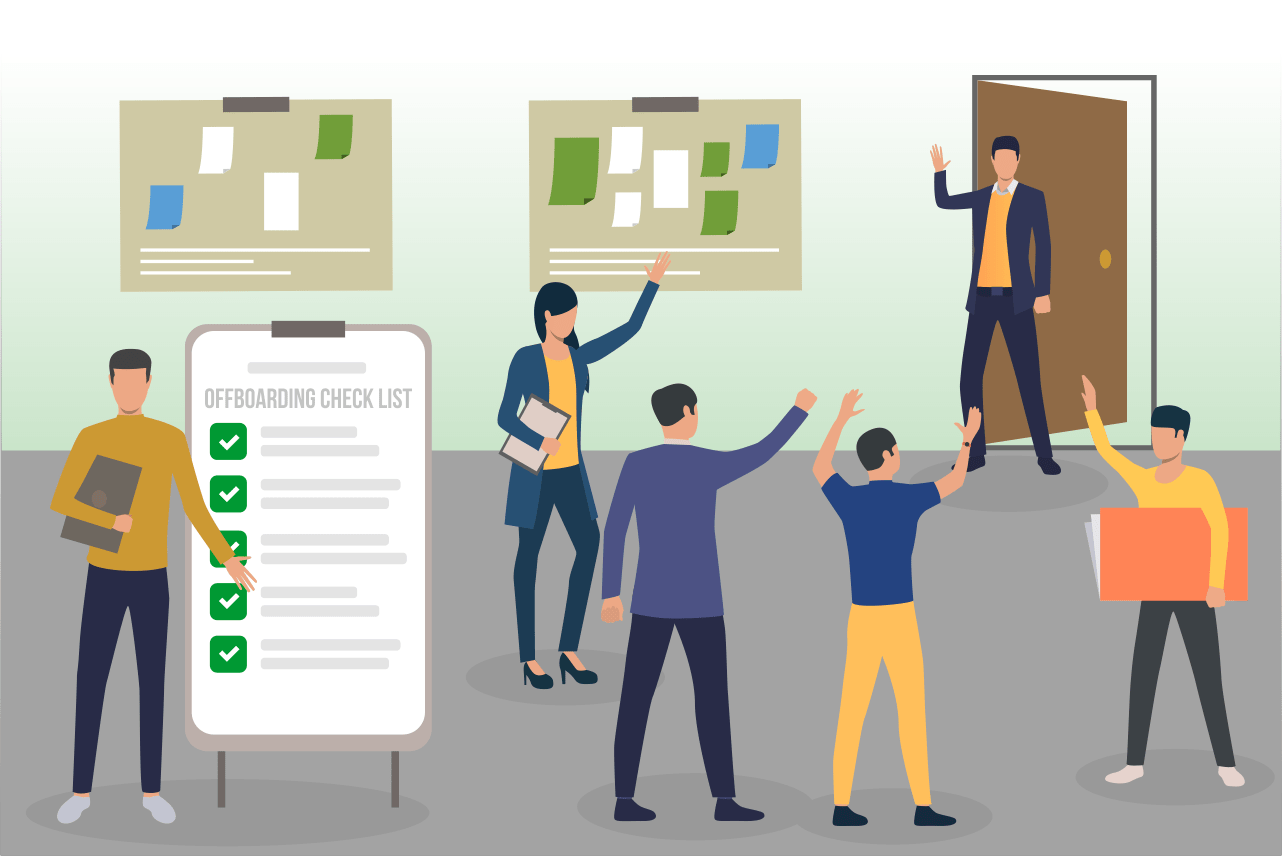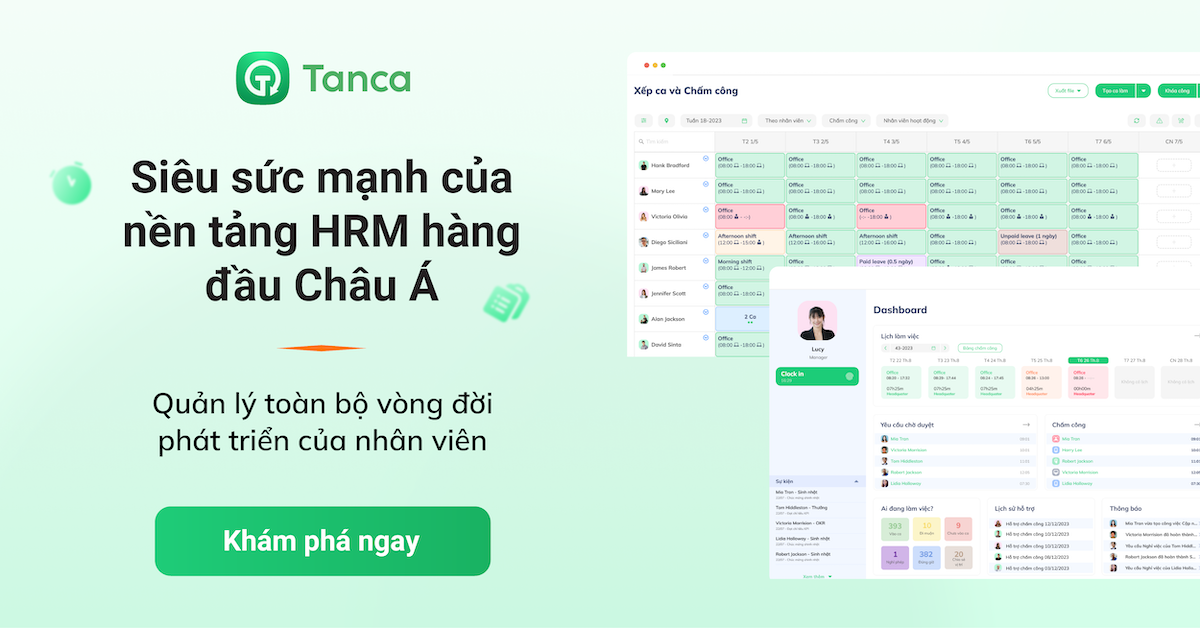A solid Offboarding Process can assist HR in avoiding common mistakes in the employee leaving process and enhancing the entire transition for both parties. But what is the offboarding process, why is it important and how to do it right? Explore below
What is offboarding in HR?

Offboarding is the process of formally separating an employee from a corporation by resignation, termination, and retirement. It includes every choice and action made throughout the course of an employee's departure.
Although this onboarding process is similar to taking a flight and assisting new hires in settling into their first job, the offboarding process is analogous to deplaning and provides employees with a formal framework when departing a position.
By completing a thorough employee offboarding process below, you can make sure that your company can amicably part ways with a departing employee.
Read more: Key Hr Metrics You Should Track And Measure
Who is responsible for offboarding?
Managers and the HR department are both accountable for offboarding new employees. The offboarding process for an employee should be walked through step-by-step by your HR department's staff, including all paperwork and legal requirements.
Difference Between Onboarding and Offboarding
An employee's tenure at a firm is divided into two phases: onboarding and offboarding.
These are two distinct processes, although they both have numerous restrictions. Employee satisfaction with the company is directly correlated to process quality, and vice versa.
When an employee is offboarding, the uncertainty is related to the choices that caused them to quit. The question of whether an employee might have been persuaded to stay may arise when one resigns from their position. Additionally, when workers are fired or laid off, they might wonder why their employer really wanted to get rid of them.
Read more: What is an advantage of hiring contingent workers?
What does offboarding consist of? - Offboarding checklists

Notify the employee of their leave
It's a good idea to come to an understanding with the employee over the specifics of their leave so as to prevent a disjointed dissemination of information and even potentially detrimental office gossip. It will be made public.
You and the staff may decide to make a formal announcement in a business meeting, a more casual email, or even simply a passing mention of it in a staff meeting, depending on the circumstance.
Assist in the successor's knowledge transfer
If you are fortunate enough to have hired a replacement for the departing employee's vacant position before their actual departure date, you will undoubtedly benefit from blocking off some time so that the departing employee may coach the replacement with some of the most important components of the job and the two of them would meet to pass over unfinished business.
Giving the new employee a heads-up on parts of the work which may not be included in a regular training session can be a fantastic approach to help them adjust to their new position.
Transition Strategy
The manager of a retiring employee should prioritize developing a transition strategy.
Asking the employee to make a list of all of their present tasks is the first step. All weekly, monthly, quarterly, yearly, and other responsibilities that they are in charge of should be included here. You ensure that this list is as thorough as possible, make sure to have a thorough brainstorming session.
Attempt to reassign duties with the goal of finding the greatest possible match based on abilities and expertise.
If your team is tiny, you may even think about asking each individual member what roles they would be willing to take on.
Recuperate corporate assets
When an employee departs your business, you must ensure that any corporate property that was in their control prior to their departure date is returned. Technology devices like laptops and smartphones may fall under this category, as well as other items of assets including.
- Laptops
- Cell phones
- Uniforms
- ID badges
- Credit cards
- Keys
To ensure that everything has been retrieved in advance, it may be useful to create a list of these corporate assets.
Update IT rights and access
To ensure that no one else can get the departing employee's PC or other data after they go, the IT staff must go through a process to disable IT access pertaining to them.
To ensure that critical communications from clients are not overlooked, it is also extremely typical to include an "out of office" notice or an automatic redirect to the email address before taking it down.
Organize a exit interview
The process of offboarding an employee must include exit interviews. A face-to-face conversation between the departing employee and a member of the Hr department, or the submission of a survey are both acceptable forms of an exit interview.
The purpose of an exit interview is to learn the employee's thoughts and opinions about the company, their suggestions for change, and their genuine reasons for leaving. The value of acting on the outcomes of exit interviews is understood by savvy businesses.
Get ready for more reference inquiries
Your former worker is probably going to provide your name and contact information so that you can serve as a reference for any future employment offers that they could receive.
For the sake of expediency and accuracy, make sure you maintain precise and thorough records pertaining to their job with you.
Check-in with the Remaining Staff
Checking in with your remaining staff is the following step after the person has left.
Your remaining staff members may face additional task difficulties depending on the importance of the now-departed individual.
It is vital to be open and sincere in these discussions and not to take anything for granted.
If you don't deal with these problems right away, your staff might soon become burned out and start looking for other jobs, which will cost you money.
Respond to Exit Interview Feedback
Despite the fact that your employee has technically already been offboarded, this is an important step that shouldn't be skipped in the process.
Your HR department should carefully evaluate the exit interview comments when the dust from their leaving has cleared and emotions are more under control.
Look for immediate action possibilities as well as ideas that may be developed as long-term goals.
Employees who claim to be departing owing to a more serious problem, including a lack of personal career advancement, should be brought up for higher-level conversations about how management staff may further improve their team's career advancement objectives.
Maybe Exit Interview Questions are useful for you.
Why is offboarding important?

Offboarding can be a challenging process to master, particularly for new employers. Concerns about employee churn have arisen throughout the epidemic because of performance unemployment rates and layoffs. Employers can make the shift simpler by effectively offboarding new employees.
In fact, an SBI study found that onboarding receives eight times more interest than offboarding. Comparable findings were made by Aberdeen, which discovered that only 29% of firms had a defined procedure in place for smoothly handling employee offboarding.
More and more businesses are realizing that loyalty need not always stop when workers opt to leave their positions. Today's workers have more autonomy and adaptability to look for new chances without tearing up their existing work relationships.
What can human resources do to ensure successful offboarding?

HR may design a thorough and empathetic offboarding program that incorporates these elements.
- Inform coworkers: When HR learns that an employee is departing, they can notify all company members through email. This reduces the likelihood of rumors damaging the departing employee's reputation.
- Expertise transfer: Make sure the expertise and knowledge of the worker are organized and prepared for the incoming hire. Send emails from clients to a colleague if the staff kept in touch with them.
- Obtain company property: To guarantee the complete return of all corporate property, keep an inventory of everything the departing employee is in possession of. This covers items such as a laptop, keycard, ID badges, outfit, and so on.
- Make contact with IT: By making sure IT disables the employee's computer, onboard computer networks, and removes data access, the organization can protect its private and classified info.
- Create any legal documents that are required: The employer and employee are both protected by letters such as those of resignation or termination, benefit agreements, and nondisclosure agreements. The best course of action is to generate these in advance and put them in the hiring manager's application monitoring system.
- Prepare for an exit interview: Strive to understand and respect the employee's requirements and viewpoint. This is a crucial chance to find out about corporate shortcomings that need to be fixed from the departing employee.
- Show your appreciation HR might prepare a farewell party and tailored gift to convey kindness as the employee goes on their upcoming adventure.
- Outsourcing services: Share with the departing employee that, in conjunction with a hr outsourcing services firm, the organization can assist them in their job search (if necessary). When reentering the job market, this could give the employee a competitive edge.
Things To Do After Employee Offboarding

Make sure to finish all unfinished business after an employee departs. Check to see if the employee's access to email, passwords, and database information has been blocked. With the help of the IT department, reroute emails and phone calls to the new contact point.
Additionally, let clients and pertinent parties know that there has been a personnel change.
The dynamics of the team are changed when an employee leaves. Therefore, as part of your offboarding process, you must keep an eye on team spirit during the transformation and after the employee quits permanently.
Assist in resolving any problems that might develop as a result of the departure. Cooperate with the team to reduce the possibility of additional resignations brought on by the reorganized work assignments and altered workplace dynamics.
FAQs
How long does it take to offboard an employee?
Based on the duration of warning issued to your employee and the reasons for termination, the employee offboarding procedure may take up to several months. Offboarding tools is used by certain businesses to expedite and automate the process of letting go of employees.
How long is offboarding process?
Their two-week notice normally kickstarts the offboarding process. It's possible that your employee has secured a different job offer with higher pay or benefits. It may be time for them to retire.
What do you do on last day of employees?
- Speak with the employee.
- Plan a farewell lunch. The company is tiny enough.
- Plan a reception.
- Examine the Gift-Giving Policy.
- Think about the tax implications.
- Select a Personalized Gift.
Conclusion
A successful offboarding procedure helps the surviving staff as well as the departing employee by enabling the latter to leave on amicable terms and preserving employee engagement and corporate loyalty.
Examining and refining your offboarding procedure may start a positive cycle where your company learns from its failures and makes improvements going forward.
Offboarding may show your past, present, and prospective workers that your company supports their advancement and is interested in improving, regardless of whether your workers return with continuous learning or split ways as friends for good.
We hope this post is useful for you. If you need HR software with a good interface, full functionality at an optimal cost for small and medium businesses, try Tanca's trial right away.









